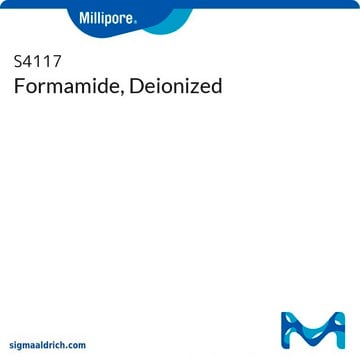F9037
Formamide
BioReagent, ≥99.5% (GC), for molecular biology
Synonim(y):
Amide C1, Formic amide
About This Item
Polecane produkty
klasa czystości
for molecular biology
Poziom jakości
gęstość pary
1.55 (vs air)
ciśnienie pary
0.08 mmHg ( 20 °C)
30 mmHg ( 129 °C)
linia produktu
BioReagent
Próba
≥99.5% (GC)
Postać
liquid
temp. samozapłonu
932 °F
metody
electrophoresis: suitable
immunohistochemistry: suitable
współczynnik refrakcji
n20/D 1.447 (lit.)
pH
4-10 (20 °C, 200 g/L)
tw
210 °C (lit.)
mp
2-3 °C (lit.)
gęstość
1.134 g/mL at 25 °C (lit.)
przydatność
suitable for nucleic acid hybridization
temp. przechowywania
2-8°C
ciąg SMILES
NC=O
InChI
1S/CH3NO/c2-1-3/h1H,(H2,2,3)
Klucz InChI
ZHNUHDYFZUAESO-UHFFFAOYSA-N
Szukasz podobnych produktów? Odwiedź Przewodnik dotyczący porównywania produktów
Opis ogólny
Zastosowanie
Other applications include:
- Preparation of brain sections of mice for BrdU immunohistochemistry
- FISH analysis of HeLa cells.
- Preparation of the polyacrylamide gel for analysis of PCR products using denaturing gradient gel electrophoresis(The Merck Index, 12th ed).
Cechy i korzyści
- Deionized for molecular biology applications
- Packaged under argon gas in amber bottles to protect from oxidation
- Used for DNA renaturation or DNA-RNA hybridization
- Reduces thermal stability of double stranded nucleic acids
Przydatność
- nucleic acid hybridization
- cryoprotectant and gel-stabilizer
- destabilize nucleic acid duplexes
- elimination of secondary structure of nucleic acids
- preparation of hybridization buffers for RNA and DNA application
Inne uwagi
produkt powiązany
Hasło ostrzegawcze
Danger
Zwroty wskazujące rodzaj zagrożenia
Zwroty wskazujące środki ostrożności
Klasyfikacja zagrożeń
Carc. 2 - Repr. 1B - STOT RE 2 Oral
Organy docelowe
Blood
Kod klasy składowania
6.1C - Combustible acute toxic Cat.3 / toxic compounds or compounds which causing chronic effects
Klasa zagrożenia wodnego (WGK)
WGK 1
Temperatura zapłonu (°F)
305.6 °F
Temperatura zapłonu (°C)
152 °C
Środki ochrony indywidualnej
Eyeshields, Gloves, type ABEK (EN14387) respirator filter
Certyfikaty analizy (CoA)
Poszukaj Certyfikaty analizy (CoA), wpisując numer partii/serii produktów. Numery serii i partii można znaleźć na etykiecie produktu po słowach „seria” lub „partia”.
Masz już ten produkt?
Dokumenty związane z niedawno zakupionymi produktami zostały zamieszczone w Bibliotece dokumentów.
Powiązane treści
Formamide is a reagent that is an ionizing solvent in aqueous buffers. It is widely utilized in biochemistry and molecular biology, particularly in nucleic acids research.
Formamid jest odczynnikiem, który jest rozpuszczalnikiem jonizującym w buforach wodnych. Jest szeroko stosowany w biochemii i biologii molekularnej, szczególnie w badaniach nad kwasami nukleinowymi.
Nasz zespół naukowców ma doświadczenie we wszystkich obszarach badań, w tym w naukach przyrodniczych, materiałoznawstwie, syntezie chemicznej, chromatografii, analityce i wielu innych dziedzinach.
Skontaktuj się z zespołem ds. pomocy technicznej




